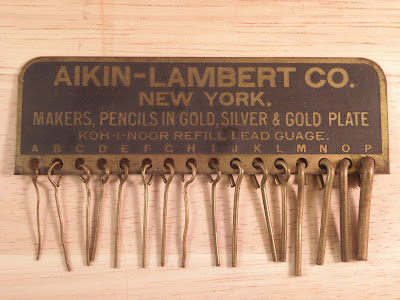This article has been edited and included in The Leadhead's Pencil Blog Volume 6, now on sale at The Legendary Lead Company. I have just a few hard copies left of the first printing, available here, and an ebook version in pdf format is available for download here.
If you don't want the book but you enjoy this article, please consider supporting the Blog project here.
(Originally scheduled to post May 13, 2018)
There were two reasons I didn’t publish these photographs after I took them four years ago or so:
The first was that I had already used pictures of the top one in an article I wrote establishing that the “Sterling.A.” mark was in fact an Aikin Lambert mark, since it bears both marks:
The other reason was that I couldn’t explain the imprints on the other one. It looks like a German pencil, with that black nose, but the top imprint is also Aikin Lambert:
The other imprint, however, puzzled me:
“L. & C. Hardtmuth’s / Kohinoor.” There are eight versions of the Koh-I-Noor trademark listed in American Writing Instrument Trademarks 1870-1953; the German firm first claimed to use the mark with respect to pencils, in 1890.
It seems an unlikely collaboration, but we know from the ALCo hallmark that the pencil was made after 1908, after Aikin Lambert had been absorbed by L.E. Waterman in 1907 (see David Nishimura’s article on the subject posted at "Waterman and Aikin Lambert"). And who was the distributor for Waterman’s pens outside of North and South America?
L. & C. Hardtmuth. The relationship ended by necessity with the outbreak of World War I in 1914, and apparently it went both ways: Hardtmuth distributed Waterman pens overseas, while Aikin Lambert – Waterman’s subsidiary – distributed Hardtmuth’s Koh-I-Noor products, including pencils . . .
. . . and lead refills, as indicated by this wire lead gauge owned by Joe Nemecek.








No comments:
Post a Comment